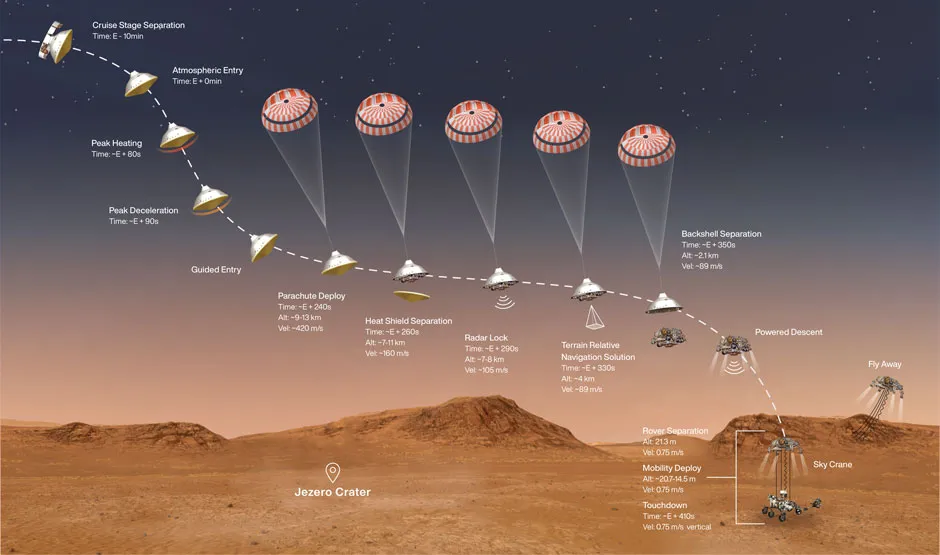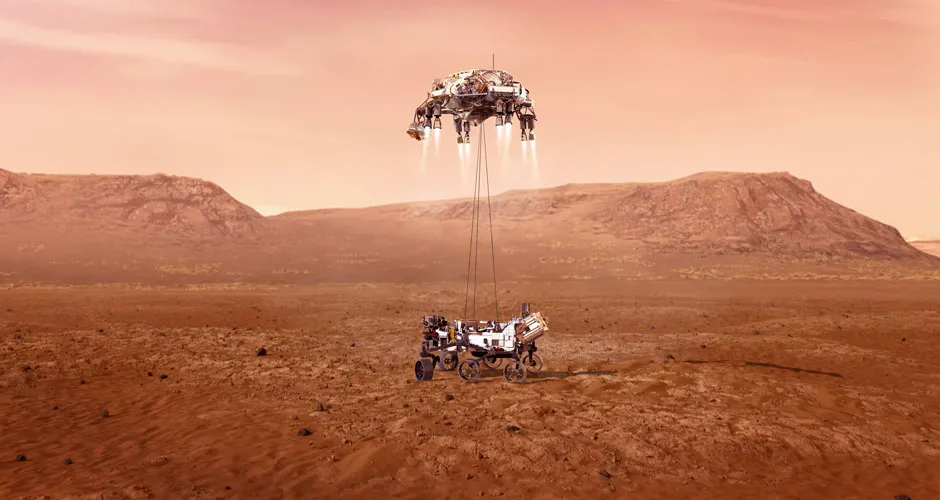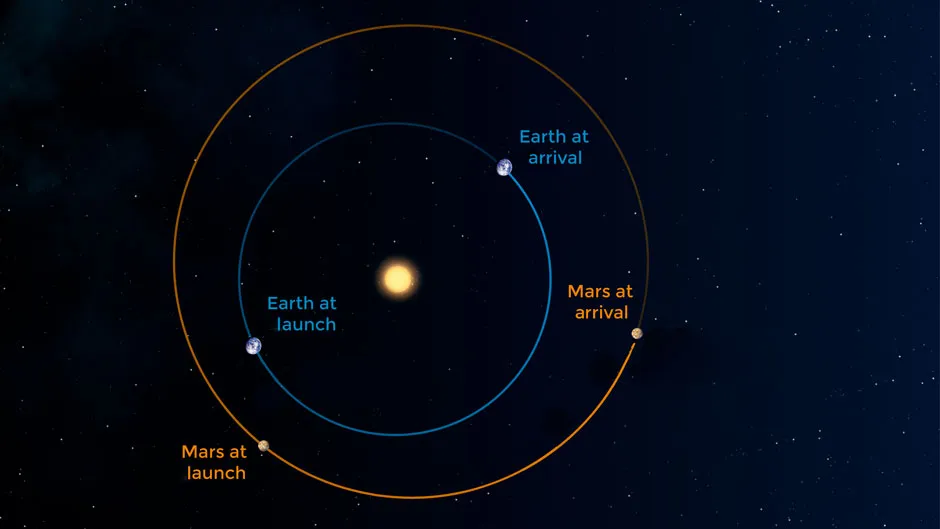It’s finally happening. After travelling over 200 million kilometres, NASA’s Perseverance rover (and Ingenuity helicopter) is preparing to land on Mars.
Tonight’s mission will be by no means easy. Although having already reached the Red Planet, Perseverance has to endure the harrowing entry, descent and landing stages – a final phase dubbed "seven minutes of terror" by many engineers.
The craft containing the rover will initially be moving over 20,000km/h across the Martian sky (over six times faster than a speeding bullet) before deploying a 20m wide parachute to slash its speed. During a rocket-powered descent, the rover – which weighs 1,025kg – will then be lowered to the surface of the Jezero Crater by a 'sky crane' hovering above (see more detail below).
Of the 14 Mars landing attempts, only eight have touched down without disaster. However, out of nine missions to the Red Planet, NASA has only failed once – 1999’s ill-fated Mars Climate Orbiter.
Could Perseverance be another success story for the US space program? There's not long until we find out.
When will the Perseverance rover land on Mars?
The Perseverance Rover is expected to land on the Martian surface at around 8.43pm (UK time) tonight, Thursday 18 February.
Perseverance is expected to first make contact with the Mars atmosphere at 8.48pm.
How can I watch the Perseverance rover land in the UK?
NASA is covering the landing live on its YouTube channel from 7.15pm in the UK. You can watch below. The stream will also be available to watch on NASA’s Facebook and Twitter accounts.
What is the Perseverance rover?
Perseverance is NASA’s high-tech nuclear battery-powered rover. It weighs a whopping 1,025kg (that's 126kg heavier than the Curiosity rover) and is about the size of a car – it’s 3m long, 2.7m wide, and 2.2m tall.
Tasked with finding evidence of past life, Perseverance is equipped with 23 cameras, a two-metre robotic arm and a drill. Using these, it aims to collect and store up to 30 rock samples during its time on the planet.
The rover’s cameras are also expected to film its landing and then transmit photos from the Martian surface soon after touching down.
Read more about the science of Mars:
- Mars: Interesting facts, figures and fun questions about the Red Planet
- The next great search for life on Mars
Perseverance is also fitted with several microphones, devices which are hoped to be the first to record sound on another planet.
The rover is by no means a fast mover, its top speed a mere 152 meters per hour. However, this pace still means it’s the fastest rover sent to Mars so far.
What is the Ingenuity helicopter?

Perseverance will also land alongside Ingenuity, a 1.8kg solar-powered mini helicopter.
NASA is hoping its carbon-fibre rotors (spinning at 24,000 RPM) will make Ingenuity the first rotorcraft to fly over Mars. Equipped with two cameras, the craft is also scheduled to capture a bird’s eye view of the planet.
With each of its flights lasting only 90 seconds each, Ingenuity will only fly 50 metres at a time (at a maximum height of 4.5m).
Where will Perseverance land?
Perseverance is aiming to touch down in the boulder-filled 45-km-wide Jezero crater.
Why? Three billion years ago, the crater hosted a river delta, a place scientists think could be home to many fossilised microorganisms.
How will Perseverance land safely?
To land, Perseverance has to successfully complete what’s called ‘EDL’, Entry, Descent, and Landing. This phase in Mars missions is also dubbed the ‘seven minutes of terror’ in which a craft is never far away from disaster.
To make matters even harder for NASA, the landing has to be completely automated. As Mars is over 200 million kilometres away, it takes more than 11 minutes to get a radio signal back to Earth.

Entry
After entering the Martian atmosphere, the Perseverance landing craft will be protected by a heat shield as it reaches temperatures over 1,300°C due to frictional forces.
During this stage, Perseverance could hit pockets of gas, potentially knocking it off course. In this event, small thrusters will correct the craft’s course.
Read more Mars about the science of Mars
- Could you throw a Frisbee on Mars?
- Could humans evolve to adapt to Mars?
- Would it be possible to fly a drone on Mars?
- What would astronauts eat on Mars?
Although the heat shield will slow the craft down to 1,600km/h, Perseverance needs to be travelling at 2.7km/h to land safely. This is why about 240 seconds after entering the atmosphere, it will deploy a parachute 21.5m in diameter.
After a further 20 seconds, the heat shield and parachute will drop away.
Powered Descent
As the Mars atmosphere is so thin, the parachute will only slow Perseverance to 320km/h – still much too fast. That’s why the rover will use a ‘skycrane’ for a rocket-powered descent. The crane will fire its rockets for 12 seconds, slowing down Perseverance for a safe landing.
Landing

As soon as Perseverance touches the ground, it will cut the rocket crane loose. The crane will then fly away and make what NASA call an “uncontrolled landing” (basically, a crash landing) a safe distance from the rover.
If you want to know more about the landing (and everything that can go wrong), check out our full guide to the “seven minutes of terror” of landing on Mars.
Why were there so many missions to Mars this year?
July 2020 was a particularly busy month for space agencies. Three missions were launched to the Red Planet: the Emirates Mars Mission, China’s Tianwen-1, and NASA’s Mars 2020 mission. (ESA’s ExoMars probe launch was postponed until 2022.) All three probes arrived in February 2021.
But why were there so many leaving Earth at one time? The reason was the so-called ‘Hohmann transfer orbit’.

To journey from Earth to Mars, a spacecraft is launched into an elliptical orbit. To save fuel (and time), the best ‘launch window’ occurs when the path between the two planets is at a minimum. This happens around the time that Earth and Mars line up with the Sun. This is known as ‘opposition’, because Mars is then exactly opposite the Sun in the sky. This alignment happens every 26 months or so.
To take advantage of this particular planetary alignment, the missions needed to start in July2020and end this February, minimising the distance each probe has to travel. Other factors, such as the capability of the launch vehicle, the mass of the
spacecraft and the desired time of arrival at Mars also help determine the exact launch date.– by Alastair Gunn.